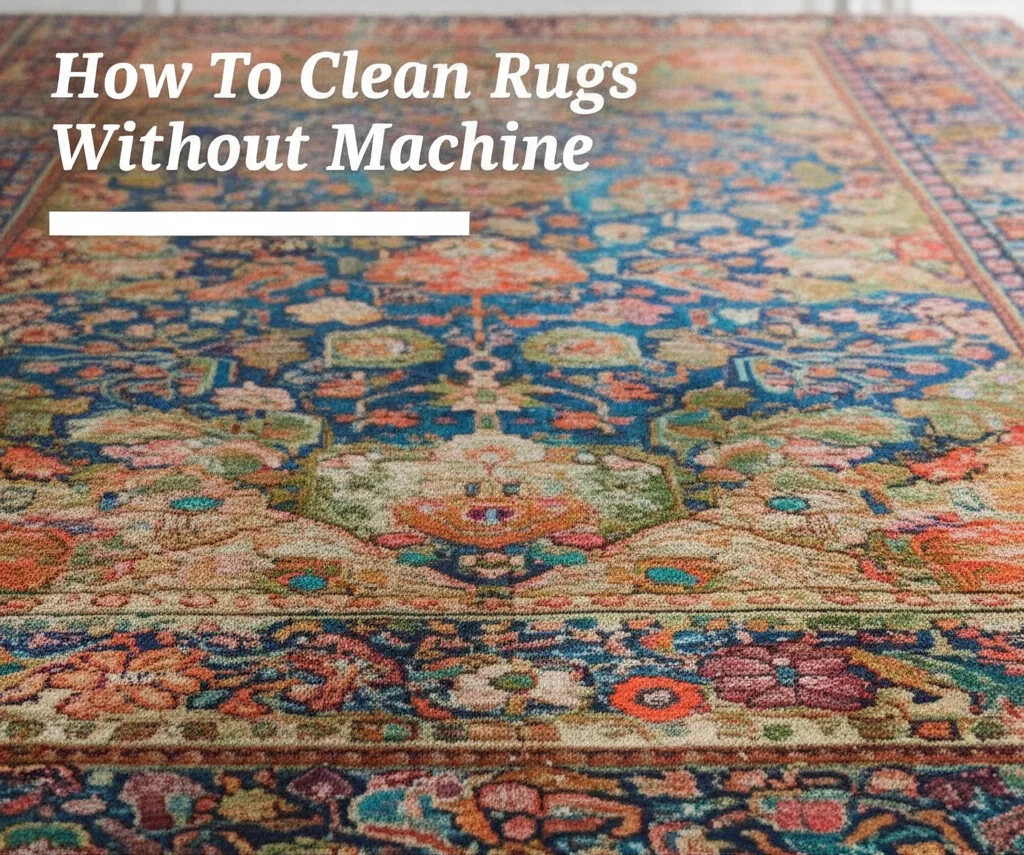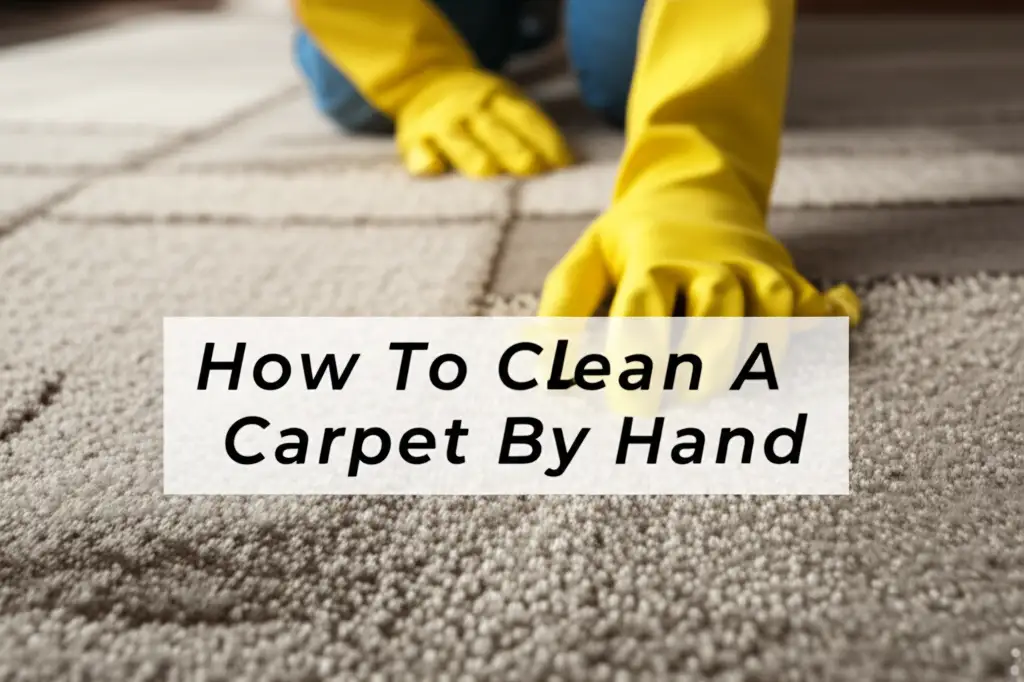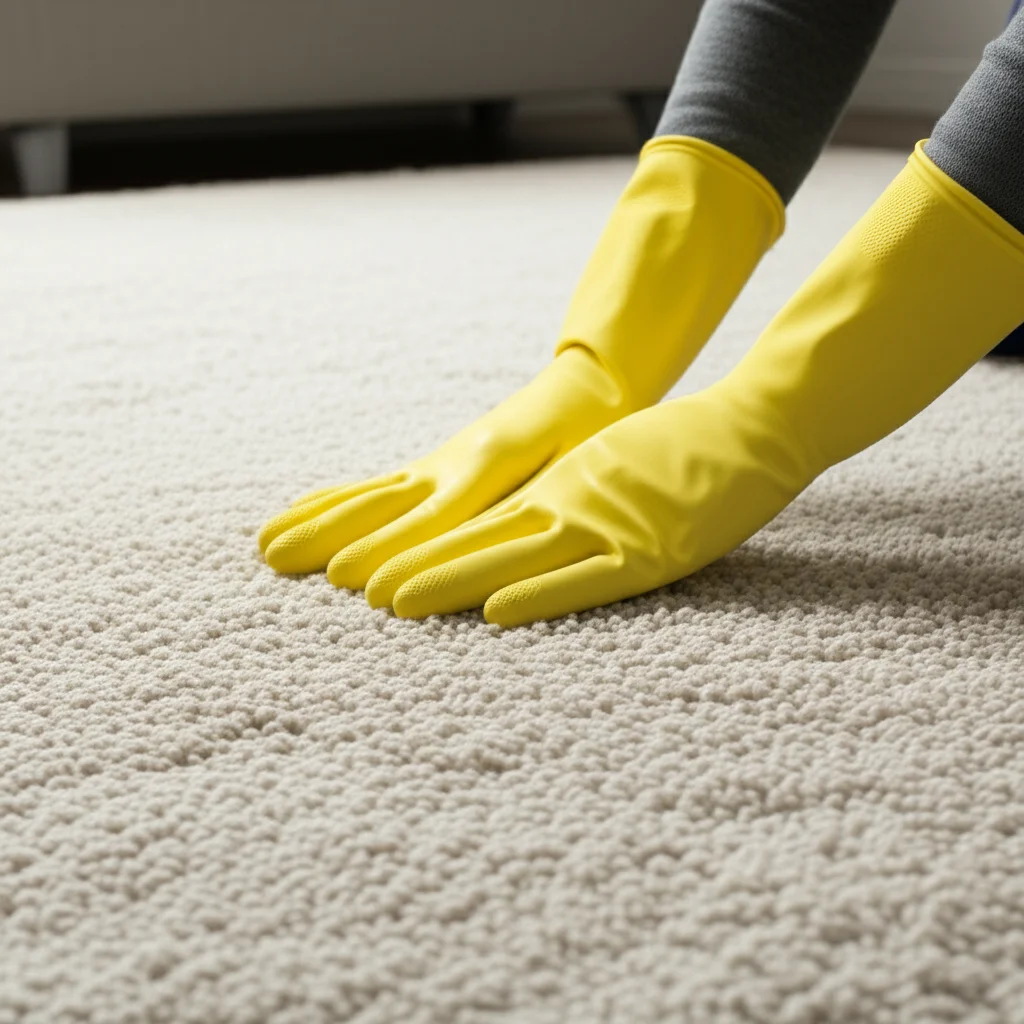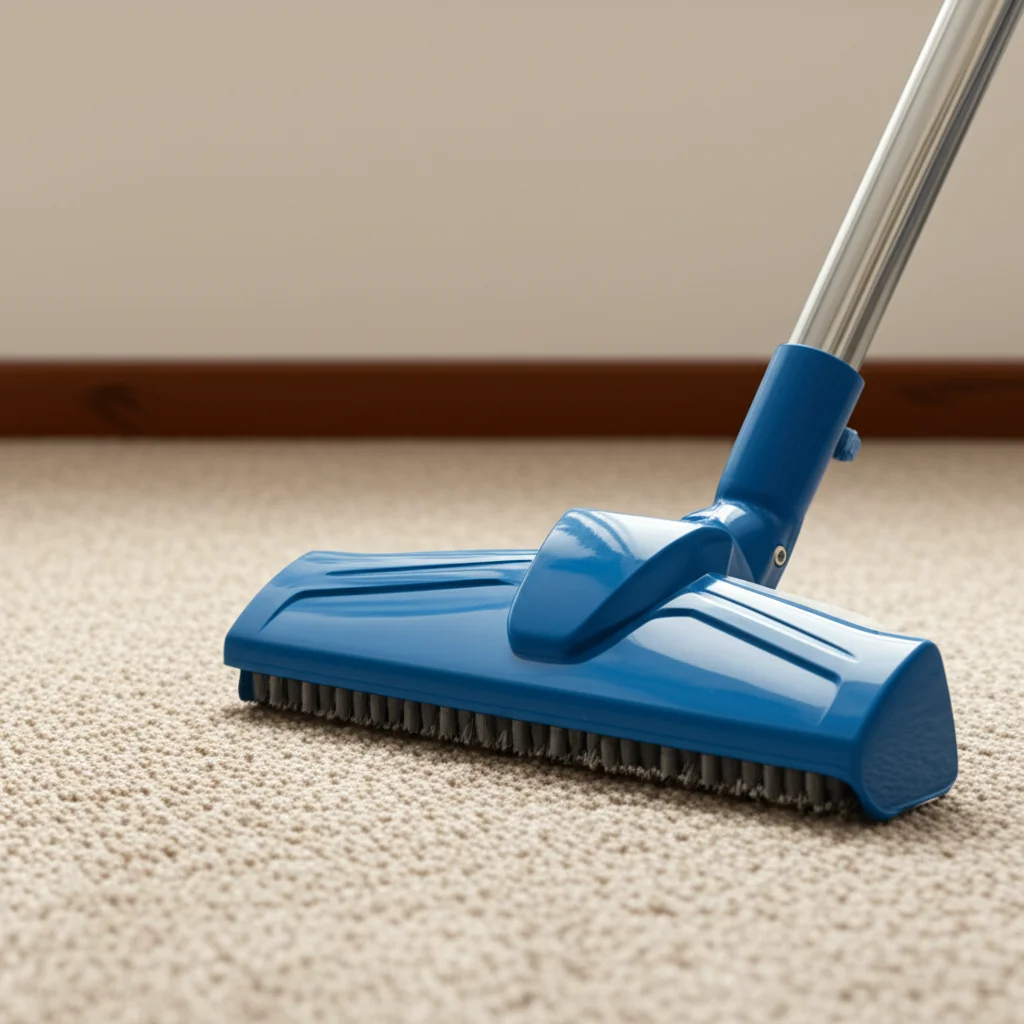· Todd Martin · Home Cleaning · 18 min read
How To Clean Rugs Without Machine

How to Clean Rugs Without a Machine for a Fresh Home
Rugs bring warmth and style to any room. However, they also collect dirt, dust, and spills daily. You might think deep cleaning requires a bulky machine, but that is not always true. Many rugs benefit greatly from a simple, hands-on approach. Learning how to clean rugs without machine ensures they stay fresh and extend their life.
I know the hassle of renting or buying a large carpet cleaner. Sometimes, a machine might even be too harsh for delicate rug fibers. This guide explains effective, gentle ways to refresh your rugs by hand. We will cover everything from daily maintenance to deep cleaning solutions. You will learn specific techniques for different rug types and how to tackle common stains. Get ready to give your rugs the care they deserve, all without the need for heavy equipment.
Takeaway
- Hand-cleaning methods preserve delicate rug fibers and extend rug life.
- Regular vacuuming, spot treatment, and airing out prevent deep dirt buildup.
- Baking soda and vinegar are powerful, natural cleaning agents for most rugs.
- Always test cleaning solutions on a hidden area first to prevent damage.
- Proper drying is crucial to avoid mold and mildew growth.
To clean rugs without a machine, start with dry methods like shaking and vacuuming. Then, use gentle solutions like baking soda for odor absorption and a mild soap or vinegar mixture for spot cleaning and surface refresh. Always test solutions first and ensure the rug dries completely to prevent mildew.
Understanding Your Rug Type Before Cleaning
Knowing your rug’s material is the first step in effective hand-cleaning. Different fibers react differently to water and cleaning agents. For instance, wool rugs need gentle, cold water and mild soap to prevent shrinking. Synthetic rugs, like nylon or polypropylene, are more durable and can handle stronger solutions.
Natural fiber rugs, such as jute, sisal, or bamboo, often require dry cleaning methods or very minimal moisture. Over-wetting these can lead to damage or mold. Cotton rugs are usually washable, but colors can bleed. Silk rugs are very delicate; professional cleaning is often best for them. Always check the rug’s care tag if it has one. If no tag exists, test your cleaning solution on a small, hidden area of the rug first. This simple test helps you avoid accidental damage or discoloration.
Essential Tools and Preparations for Hand Cleaning
Before you begin cleaning your rug by hand, gather the right tools. Having everything ready makes the process smoother and more efficient. You do not need anything expensive or hard to find. Most items are likely already in your home.
Here is a list of what you will need:
- Vacuum cleaner or stiff brush: For dry soil removal.
- Bucket or spray bottle: For mixing and applying cleaning solutions.
- Clean cloths or sponges: For blotting and scrubbing.
- Mild dish soap or carpet shampoo: Choose a pH-neutral product.
- White vinegar: A natural deodorizer and cleaner.
- Baking soda: Great for absorbing odors and moisture.
- Soft-bristled brush or broom: For working solutions into fibers.
- Access to water: For rinsing.
- Fan or dehumidifier: To aid in drying.
- Rubber gloves: To protect your hands.
Prepare your cleaning area by moving furniture. If cleaning a smaller rug, you can take it outside. For larger rugs, protect your floors underneath with plastic sheeting or old towels. This prevents water or cleaning solutions from damaging your flooring. Always remove loose dirt and debris before applying any liquid. This step is crucial for effective cleaning.
Step-by-Step Dry Cleaning and Deodorizing Rugs
Dry cleaning is an excellent first line of defense for rugs, especially those that cannot tolerate much water. It helps remove loose dirt, dust, and odors without saturating the fibers. This method is also perfect for routine maintenance between deeper cleans.
Follow these steps for effective dry cleaning:
- Shake it out: Take smaller rugs outside and give them a good shake or beat them gently with a broom handle. This dislodges deeply embedded dry dirt and dust. For larger rugs, this step is not practical.
- Vacuum thoroughly: Use a powerful vacuum cleaner on both sides of the rug. Vacuum slowly and in multiple directions to pick up as much dirt as possible. Focus on high-traffic areas. If you have a How to Clean Ruggable Rugs, you might consider machine washing the top layer. However, for a fully machine-free approach, focus on these dry methods.
- Apply baking soda: Sprinkle a generous amount of baking soda evenly over the entire rug surface. Baking soda is a natural deodorizer. It absorbs odors and some moisture from the rug fibers.
- Let it sit: Allow the baking soda to sit for at least 15-30 minutes, or longer for stubborn odors (up to several hours or overnight).
- Vacuum again: Thoroughly vacuum up all the baking soda. Ensure no residue remains. This step removes the baking soda along with the absorbed odors and fine dust particles.
- Brush out matted areas: Use a soft-bristled brush to gently lift and restore the pile in any matted areas. This helps the rug look fresh.
This dry method is quick, easy, and extends the time between wet cleaning sessions. It is also a good option for rugs that are too delicate for water.
Targeted Spot Cleaning for Stains
Spills and stains happen. Spot cleaning immediately is the most effective way to prevent them from setting. The key is to act fast and use the right technique for different types of stains. Avoid rubbing the stain, as this can spread it and push it deeper into the rug fibers.
Here is how to effectively spot clean various common stains:
- Fresh Liquid Spills:
- Blot, do not rub. Use a clean, dry white cloth or paper towel. Apply firm pressure to absorb as much liquid as possible.
- Work from the outside of the spill inwards to prevent spreading.
- Continue blotting until no more liquid transfers to the cloth.
- General Stains (Dirt, Food, Pet Accidents):
- Mix a small amount of mild dish soap (or a specific rug cleaning solution) with lukewarm water.
- Lightly dampen a clean cloth with the solution. Do not saturate the cloth.
- Gently blot the stained area. Do not rub.
- Rinse the cloth with plain water and blot the area again to remove soap residue.
- Repeat until the stain is gone.
- Grease Stains:
- Sprinkle a generous amount of cornstarch or baking soda directly onto the grease stain.
- Let it sit for at least 15-30 minutes to absorb the grease.
- Vacuum up the powder.
- If a residue remains, gently blot with a cloth dampened with a mild soap solution, then blot with plain water.
- Pet Stains (Odor and Stain):
- Blot up as much of the pet mess as possible.
- Mix a solution of equal parts white vinegar and water.
- Lightly spray or blot the area with the vinegar solution. Vinegar neutralizes odors and helps with stains.
- Let it sit for 10-15 minutes.
- Blot thoroughly with clean water, then blot dry.
- For persistent odors, you can sprinkle baking soda after the area is dry, let it sit, then vacuum. This method is also effective for How to Keep Dogs From Peeing on Rugs, though prevention is always key.
Always test any cleaning solution on an inconspicuous area of your rug first. This ensures it does not cause discoloration or damage. Blotting is always better than rubbing.
Deep Cleaning Your Rugs by Hand
Sometimes, a rug needs more than just spot cleaning or deodorizing. A full deep clean by hand can refresh its entire appearance and eliminate deeply embedded dirt. This process requires more effort but yields excellent results without the need for a machine.
Before you start, ensure your rug type can withstand a wet cleaning. Wool, synthetic, and most cotton rugs are generally safe. Natural fibers like jute or sisal are usually not suitable for this method.
Follow these steps for a thorough hand deep clean:
- Prepare the area: If the rug is small, take it outside on a clean, paved surface or a tarp. For larger rugs indoors, lay down plastic sheeting and old towels to protect your floor.
- Vacuum or shake: Remove all loose dirt and debris from both sides of the rug. This prevents dirt from turning into mud during the wet cleaning.
- Mix your cleaning solution:
- For a general clean, mix a few drops of mild dish soap or a specialized carpet shampoo with warm water in a bucket. Use only a small amount of soap to avoid excessive suds.
- For a natural approach, mix one part white vinegar with ten parts water. You can add a few drops of essential oil like lavender for a pleasant scent.
- Test the solution: Apply a small amount of your chosen solution to an inconspicuous area of the rug. Wait a few minutes to ensure there is no discoloration or adverse reaction.
- Apply the solution:
- For smaller rugs, you can gently immerse a clean sponge or soft-bristled brush in the solution. Wring out excess liquid.
- For larger rugs, you can use a spray bottle to lightly mist the rug surface. Do not saturate the rug. The goal is to dampen, not soak.
- Agitate the fibers: Using your sponge or soft-bristled brush, gently work the solution into the rug fibers. Work in small sections. Brush in the direction of the pile to prevent damage. Be gentle, especially on delicate fibers. For specific types like How to Clean Bamboo Rugs or How Do You Clean Braided Rugs, specific instructions might be needed; however, the principle of gentle agitation applies.
- Rinse thoroughly: This is a crucial step. Use a clean cloth dampened with plain water to blot up the dirty solution. Rinse the cloth frequently and continue blotting until no more soap residue or dirt comes up. You may need multiple buckets of clean water for this. You can also use a wet-dry vacuum if available to extract water, but it is not necessary for a machine-free clean.
- Final rinse (optional): For a very thorough rinse, you can use a garden hose on a low setting for outdoor rugs, or spray plain water onto the rug with a spray bottle indoors. Immediately blot up all excess water.
- Squeegee (optional): For low-pile rugs, a clean squeegee can help remove excess water and speed up drying.
Deep cleaning by hand takes time and effort. However, it results in a visibly cleaner, fresher rug. It allows you to control the amount of moisture and pressure, which protects your rug better than some machines.
Special Considerations for Different Rug Materials and Types
Not all rugs are created equal when it comes to cleaning. Different materials require specific care to avoid damage. Understanding these nuances is vital for successful machine-free cleaning.
Here are some common rug types and their special cleaning considerations:
- Wool Rugs:
- Wool is durable but can shrink or felt with hot water or harsh chemicals.
- Use cold or lukewarm water and a pH-neutral, wool-safe cleaner.
- Avoid excessive rubbing. Blot gently.
- Dry flat or hang to prevent stretching.
- Synthetic Rugs (Nylon, Polypropylene, Polyester):
- These are generally very durable and stain-resistant.
- They can handle most mild cleaning solutions and lukewarm water.
- They dry relatively quickly.
- You can be a bit more vigorous with brushing compared to natural fibers.
- Cotton Rugs:
- Often washable, but check for colorfastness first. Colors can bleed.
- Use cold water and a gentle detergent.
- Can often be hand-washed in a large tub or hosed down outside.
- Ensure even drying to prevent shrinking or warping.
- For How to Wash Bathroom Rugs with Rubber Backing or How to Clean Large Rubber-Backed Rugs, hand cleaning is often safer than machine washing to preserve the backing.
- Natural Fiber Rugs (Jute, Sisal, Seagrass, Bamboo):
- These are highly susceptible to water damage, warping, and mold.
- Prioritize dry cleaning methods (vacuuming, shaking).
- For spills, blot immediately with a dry cloth.
- If wet cleaning is absolutely necessary, use minimal moisture and dry very quickly. A solution of white vinegar and water can be used sparingly.
- Avoid soaking at all costs.
- For How to Clean Bamboo Rugs, gentle brushing and immediate drying are key.
- Silk Rugs:
- Extremely delicate and expensive.
- Water can damage silk fibers, causing colors to bleed or the rug to become stiff.
- Spot cleaning should be done with extreme caution, using minimal moisture and a very mild solution.
- Often, professional cleaning is recommended for silk rugs.
- Braided Rugs:
- Can be made of various materials (cotton, wool, synthetics).
- The cleaning method depends on the material.
- For How Do You Clean Braided Rugs, small ones can often be submerged in a tub of water with mild soap, then rinsed thoroughly. Large ones require spot cleaning and air drying.
- Fringe on Oriental Rugs:
- Fringe can be delicate and tangle easily.
- For How to Clean Fringe on Oriental Rugs, use a gentle brush and a diluted solution. Avoid strong scrubbing.
- Dry the fringe carefully to prevent yellowing.
Always prioritize gentle methods and less moisture, especially for natural or delicate fibers. When in doubt, consult a professional rug cleaner.
Proper Drying Techniques to Prevent Mold and Mildew
After wet cleaning your rug, proper drying is perhaps the most critical step. Incomplete drying can lead to several problems. These include mold, mildew, unpleasant odors, and even damage to your floor underneath. A properly dried rug stays fresh and lasts longer.
Follow these essential drying techniques:
- Remove excess water:
- After rinsing, blot the rug thoroughly with clean, dry towels. Press down firmly to absorb as much moisture as possible.
- For larger rugs, you can walk on the towels to help press out more water.
- If you have a wet-dry vacuum, you can use it to extract remaining moisture, but this is an optional step if you are strictly avoiding machines.
- Elevate the rug:
- Never dry a rug flat on the floor, especially if it has a backing or is a thick pile.
- Hang smaller rugs over a clothesline, chairs, or a railing. Ensure air can circulate around both sides.
- For larger rugs, elevate them on blocks, sawhorses, or an outdoor patio set. This allows airflow underneath.
- If drying indoors, place something underneath to protect your floor. This is especially important for How to Clean Area Rugs on Laminate Floors to prevent moisture damage.
- Ensure good air circulation:
- Open windows and doors to create cross-ventilation.
- Use fans to direct airflow over and under the rug. Ceiling fans also help.
- A dehumidifier can significantly speed up the drying process, especially in humid environments.
- Flip and rotate:
- Periodically flip the rug over or rotate it to ensure even drying.
- Check for damp spots regularly.
- Sunlight (with caution):
- Sunlight can help dry rugs and kill bacteria. However, direct, prolonged sunlight can fade rug colors, especially on natural fiber or brightly dyed rugs.
- If using sunlight, limit exposure or choose a spot with indirect sun.
- Be patient:
- Drying can take anywhere from a few hours to a few days, depending on the rug’s thickness, material, and humidity levels.
- Do not put the rug back in its place until it is completely dry to the touch, both top and bottom. Check for any lingering dampness or musty smells.
Proper drying prevents major problems. It keeps your rug looking good and smelling fresh. It also protects your home environment from mold and mildew issues.
Routine Maintenance for Long-Lasting Freshness
Regular maintenance is key to keeping your rugs looking their best between deep cleans. A consistent routine prevents dirt from building up and extends the life of your rugs. These simple habits require minimal effort but make a big difference.
Here are essential routine maintenance tips:
- Vacuum Regularly:
- Vacuum your rugs at least once a week, more often in high-traffic areas or homes with pets.
- Vacuum in different directions to dislodge dirt from all sides of the fibers.
- For smaller rugs, take them outside and shake them out before vacuuming.
- Rotate Your Rugs:
- If possible, rotate your rugs every 6-12 months. This ensures even wear and prevents one area from fading or becoming more compressed than others due to traffic or sunlight.
- Address Spills Immediately:
- As discussed, prompt spot cleaning is crucial. The longer a spill sits, the harder it is to remove. Always blot, never rub.
- Use Rug Pads:
- A good quality rug pad offers several benefits. It prevents the rug from slipping (important for safety, especially on hardwood or tile floors), adds cushioning, and helps protect the rug from wear and tear. It also allows some airflow underneath, which is good for the rug and your floors. Consider how a rug pad helps How to Keep Rugs from Slipping on Tile or How to Keep Area Rugs from Slipping on Hardwood Floors.
- Air Out Rugs:
- Periodically, take smaller rugs outside on a sunny, breezy day to air them out. This helps remove lingering odors and freshens the fibers naturally.
- Trim Loose Ends:
- If you notice any loose threads or snags, trim them with scissors. Do not pull them, as this can unravel the rug.
- Professional Cleaning (Optional):
- Even with diligent hand cleaning, some rugs may benefit from professional cleaning every few years, especially valuable or delicate ones. This is usually only needed for very deep-seated dirt or stains that DIY methods cannot handle.
By following these routine maintenance steps, you can significantly prolong the beauty and lifespan of your rugs. You will maintain a clean, fresh home environment with minimal effort.
Troubleshooting Common Problems
Even with the best cleaning methods, you might encounter a few common rug problems. Knowing how to troubleshoot them without a machine can save you time and frustration.
Here are solutions for typical rug issues:
- Lingering Odors:
- Cause: Incomplete drying, pet accidents, or embedded smells.
- Solution: Reapply baking soda generously. Let it sit for several hours or overnight, then vacuum thoroughly. For stubborn odors, mix white vinegar and water (1:1 ratio), lightly mist the area, blot dry, then apply baking soda once fully dry. Ensure proper air circulation.
- Water Stains or Rings:
- Cause: Over-wetting, or dirty water left to dry.
- Solution: Dampen a clean cloth with plain water and blot the entire affected area. Do not rub. This helps redistribute the moisture and often evens out the appearance. Work from the outside of the ring inward. Repeat if necessary, then dry completely and quickly with fans.
- Matted Pile:
- Cause: Heavy foot traffic, furniture pressure.
- Solution: Lightly mist the matted area with water. Use a soft-bristled brush or the edge of a spoon to gently lift and separate the fibers. You can also try gently blowing warm air from a hairdryer (on a low setting) while brushing to help lift the pile.
- Fading Colors:
- Cause: Prolonged exposure to direct sunlight.
- Solution: Unfortunately, fading is often permanent. To prevent further fading, rotate your rugs regularly, use UV-blocking window films, or place rugs in areas with less direct sunlight.
- Fringe Problems (Tangling, Yellowing):
- Cause: General wear, improper cleaning/drying.
- Solution: Gently detangle fringe with your fingers or a wide-tooth comb. For yellowing, mix a small amount of hydrogen peroxide (3%) with water (1:1 ratio) and gently blot the fringe with a white cloth. Rinse thoroughly and dry quickly. Remember, for detailed How to Clean Fringe on Oriental Rugs information, refer to specific guides.
Remember, patience and gentle techniques are your best allies when troubleshooting rug issues by hand. Always test new solutions on an inconspicuous area first.
FAQs About Cleaning Rugs Without a Machine
Q: Can I really deep clean a large area rug without a machine? A: Yes, you can. While it requires more effort than using a machine, deep cleaning a large area rug by hand is entirely possible. You will need to work in sections, using appropriate cleaning solutions, gentle agitation with a brush, and thorough rinsing and drying techniques. Proper ventilation and air circulation are crucial for large rugs to prevent mildew.
Q: What is the best natural cleaner for rugs? A: Baking soda and white vinegar are excellent natural cleaners for rugs. Baking soda absorbs odors and helps lift dirt. White vinegar, diluted with water, acts as a natural deodorizer and mild disinfectant. A combination of both is effective for many common rug cleaning tasks and stains.
Q: How often should I clean my rugs by hand? A: The frequency depends on foot traffic, pet presence, and personal preference. For general maintenance, vacuuming weekly and spot cleaning spills immediately is ideal. A deeper hand clean might be needed every 6-12 months for high-traffic rugs, or every 1-2 years for less-used rugs.
Q: How do I remove pet urine smell from a rug without a machine? A: For pet urine, blot up as much liquid as possible first. Then, mix equal parts white vinegar and water and saturate the spot. Let it sit for 10-15 minutes to neutralize the odor. Blot thoroughly with clean water, then blot dry. Once dry, sprinkle baking soda over the area, let it sit for hours, then vacuum.
Q: Is it safe to use hydrogen peroxide on rugs? A: Hydrogen peroxide (3%) can be effective for light-colored rugs and stains like blood or mildew. However, it acts as a mild bleaching agent. Always dilute it with water and test on an inconspicuous area first. It is not recommended for dark or delicate colored rugs, as it may cause discoloration.
Q: How long does it take for a hand-cleaned rug to dry completely? A: Drying time varies significantly. It depends on the rug’s thickness, material, how much moisture was used, and environmental conditions. A thin rug in a well-ventilated, low-humidity area might dry in a few hours. A thick, dense rug in a humid environment could take 24-48 hours or even longer. Ensure it is completely dry before putting it back.
Conclusion
Cleaning rugs without a machine is a practical, effective, and often gentler way to maintain their beauty and longevity. We have explored everything from daily dry maintenance to deep hand-cleaning techniques and essential spot treatment. You now understand the importance of identifying your rug’s material and using the right tools and solutions for each task. The secret to long-lasting rug freshness lies in consistent care, quick action on spills, and ensuring thorough drying.
By embracing these machine-free methods, you take control of your home’s cleanliness. You extend the life of your beloved rugs. You can enjoy a clean, fresh living space without the need for expensive equipment or harsh chemicals. Start implementing these tips today. Your rugs and your home will thank you!





